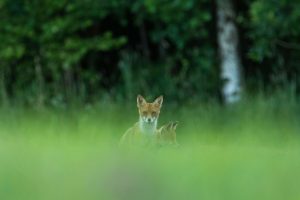The Hypnotic Power of Animals
By Susanne Karr

Animals spark our imagination. This is reflected in the integration of so-called “power animals” in trance journeys, which are applied in various ways in personality development and hypnosis. In my work as a hypnosis coach, I integrate this wonderful tool frequently. The idea and practice of meeting a power animal draws from animistic backgrounds inspired by holistic worldviews of various kinds. The power animal journey is of particular interest in transformational contexts.
Animals as part of us
Based on the assumption that personalities are composed of a number of different parts, I would like to invite you to a thought experiment, namely, to imagine one of these parts as an animal part. The idea may not be as far-fetched as it sounds at first. The experiment could inspire imaginary flying—as occurs in dreams sometimes. Shifting into a being with wings might bring an exhilarating rush as the air currents lift and carry, granting a sense of freedom and perspective unlike anything experienced on two feet. Or maybe you might find yourself living in water, experiencing a sensation of weightlessness and fluid movement, where every motion becomes effortless and graceful, embracing a world of rhythmic flow.
If we go back many, many generations into the past, there must be ancestors in animal form in our family line—otherwise we would be negating evolution. Animals as our ancestors are kin— and not only in the mythological sense. As I put it in my book on human relationship with other animals:
In an inclusive ancestral line, which allows a cross-species retrospective, the image of a primordial mother of all living beings emerges. Animism refers to an earth mother of uncertain form. . . . In the mythical animal body of the ancestress, in whose power it lays to bring forth the most diverse beings—not only in the variety of shapes and colors, but also in terms of gender—the further manifestations of animals and humans are equally contained. (p. 49)
Neuroscientific research also confirms stronger connections between species. For a long time, brain research believed that more and more “capable” layers were superimposed on each other during evolution until homo sapiens emerged as an intelligent high-flyer. Neuropsychologists Joseph Cesario, David J. Johnson, and Heather L. Eisthen contradict this:
A widespread misconception in much of psychology is that (a) as vertebrate animals evolved, “newer” brain structures were added over existing “older” brain structures, and (b) these newer, more complex structures endowed animals with newer and more complex psychological functions, behavioral flexibility, and language. This belief, although widely shared in introductory psychology textbooks, has long been discredited among neurobiologists and stands in contrast to the clear and unanimous agreement on these issues among those studying nervous-system evolution.
This observation demands a new view of animals and the human position toward them. It strengthens the consciousness of kinship, as previous certainties are shaken. Researchers have discovered enormous intellectual, spatial, or experiential abilities in animals. Think of architectural masterpieces such as termite burrows, echo sound communication in dolphins, or monkeys knowing when their favorite fruits are ripe and setting off to enjoy them.
There seems to be hope for recalibrating human-animal relationships on a larger scale. As Cesario et al. write, it is time to acknowledge these connections and let go of backward-looking thought patterns and instead “recognize cross-species connections.” As this research shows, connections manifest on a material level and are more than just fanciful notions or daydreams. These findings challenge the hierarchies between humans and animals. They demand massive changes in the way we deal with them.
Individuality, not attribution
Animals are persons with individual characteristics. If they were once again just metaphors for repressed parts of human beings, they would not be able to tell us anything interesting that we do not yet know. Instead, connecting with an individual animal can be conducive to personal development.
In hypnosis, it is possible to get closer to the playful communication or the fabulous capabilities of perception of an animal. A world shows up that relates to the real animal with their specific characteristics. This encounter can be wonderfully shaped during trance, because, as in dreams, it is about images and feelings, not logic. The experience of conversion with animal spirits might deepen an awareness of kinship.
The connection with a power animal is not about a specific statement or instruction that they give us. Images that arise in a guided trance do not engage our awareness with measurable facts, but with the power of symbols and the unconscious. With colors and atmospheres and perhaps—who knows for sure—insights that only gradually emerge, maybe just a few moments or days later. It is up to us to make something out of the clues, the inspiration. Instead of interpretation as in traditional or metaphorical ways, the power animal is seen as a special being with a message that can be revealed or passed on in a poetic or symbolic way.
Shapeshifting
The encounter with the power animal allows us to change perspective, find new solutions, or engage with parts of ourselves. It is about learning from the animals, finding out what it is like to be like them, to merge and connect with them: to engage with the animal’s aliveness from within. This helps us to respect the animal themselves much more deeply and see them as real beings with their own subjective perceptions of the world.
In a guided trance, clients try to find an animal who has a message for them. This animal can be any animal. It can be as small as an ant or a butterfly, or it can be as huge as a whale. Maybe it’s a bird. Each of them channels different energies or different capabilities.
Shapeshifting into that power animal, or even just imagining the colors of the fur, the shell, or the feathery wings, it is possible to experience what it’s like, for example, to fly like a seagull, or to change colors in seconds like an octopus, or to dance through the desert on the elegant hooves of a gazelle. An experience like this already provides the client with different insights than their contemporary human self might gain. In this process, unforeseen images emerge. In the power animal journey, we have the honor and privilege of learning from an animal, from their own way of being, knowing, their presence, and their maturity.
#
Dr. Susanne Karr is a coach and independent scholar deeply intrigued by the dynamics of interconnectedness, communication, and transformative growth. Her coaching practice combines systemic counseling and hypnosis. As a philosopher, she delves into human-animal relations and alternative modes of conveyance, exemplified in her book “Connectedness” (Verbundenheit) and her blog “Striped Insights.”
Counterpoint blogs may be reprinted with the following acknowledgement: “This article was published by Counterpoint: Navigating Knowledge on 13 March 2024.”
The views and opinions expressed on this website, in its publications, and in comments made in response to the site and publications are those of the author(s) and do not necessarily reflect the views and opinions of Counterpoint: Navigating Knowledge, its founders, its staff, or any agent or institution affiliated with it, nor those of the institution(s) with which the author is affiliated. Counterpoint exists to promote vigorous debate within and across knowledge systems and therefore publishes a wide variety of views and opinions in the interests of open conversation and dialogue.
Image credit: © Mindaugas Vitkus/unsplash



